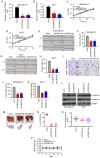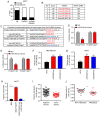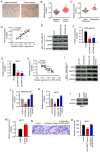lncRNA PCNAP1 predicts poor prognosis in breast cancer and promotes cancer metastasis via miR‑340‑5p‑dependent upregulation of SOX4
- PMID: 32945462
- PMCID: PMC7448480
- DOI: 10.3892/or.2020.7699
lncRNA PCNAP1 predicts poor prognosis in breast cancer and promotes cancer metastasis via miR‑340‑5p‑dependent upregulation of SOX4
Abstract
The high metastatic rate of breast cancer is the significant cause of its poor prognosis. The long noncoding RNA (lncRNA) proliferating cell nuclear antigen pseudogene 1 (PCNAP1) plays important roles in the initiation and progression of cancers; however, its regulatory function and molecular mechanism in breast cancer metastasis remains unknown. Therefore, we investigated the roles of lncRNA PCNAP1 in breast cancer metastasis by modulating the microRNA (miR)‑340‑5p/SOX4 axis using quantitative real‑time PCR, in vivo mouse models, nucleo‑cytoplasmic separation, western blot analysis, scratch assays, Transwell assays, luciferase reporter assays and MS2‑RIP, in vitro and in vivo. lncRNA PCNAP1 was found to be upregulated in human breast cancer tissues, and high lncRNA PCNAP1 levels predicted poor overall survival. Function assays showed that knockdown of lncRNA PCNAP1 suppressed the migration and invasion of breast cancer cells in vitro and in vivo. Mechanistically, lncRNA PCNAP1 functioned as a competing endogenous (ce)RNA for miR‑340‑5p to facilitate the expression of its target gene SRY‑box transcription factor 4 (SOX4), promoting migration and invasion of breast cancer cells. Overall, we found that lncRNA PCNAP1 predicted a poor prognosis in breast cancer and promoted cancer metastasis via miR‑340‑5p‑dependent upregulation of SOX4 expression. These results suggest that lncRNA PCNAP1 has potential as an alternative therapeutic target to suppress breast cancer metastasis.
Keywords: lncRNA PCNAP1; miRNA‑340‑5p; SOX4; breast cancer; cancer metastasis.
Figures







Similar articles
-
lncRNA SNHG3 promotes breast cancer progression by acting as a miR‑326 sponge.Oncol Rep. 2020 Oct;44(4):1502-1510. doi: 10.3892/or.2020.7690. Epub 2020 Jul 15. Oncol Rep. 2020. Retraction in: Oncol Rep. 2022 Mar;47(3):44. doi: 10.3892/or.2022.8255. PMID: 32945476 Free PMC article. Retracted.
-
miR-140-5p is negatively correlated with proliferation, invasion, and tumorigenesis in malignant melanoma by targeting SOX4 via the Wnt/β-catenin and NF-κB cascades.J Cell Physiol. 2020 Mar;235(3):2161-2170. doi: 10.1002/jcp.29122. Epub 2019 Aug 6. J Cell Physiol. 2020. PMID: 31385607
-
Long non coding RNA OIP5‑AS1 promotes metastasis of breast cancer via miR‑340‑5p/ZEB2 axis.Oncol Rep. 2020 Oct;44(4):1662-1670. doi: 10.3892/or.2020.7724. Epub 2020 Aug 10. Oncol Rep. 2020. PMID: 32945479 Free PMC article.
-
The regulatory roles of lncRNAs in the process of breast cancer invasion and metastasis.Biosci Rep. 2018 Sep 28;38(5):BSR20180772. doi: 10.1042/BSR20180772. Print 2018 Oct 31. Biosci Rep. 2018. PMID: 30217944 Free PMC article. Review.
-
Unveiling the functions of five recently characterized lncRNAs in cancer progression.Clin Transl Oncol. 2025 Feb;27(2):458-465. doi: 10.1007/s12094-024-03619-w. Epub 2024 Jul 27. Clin Transl Oncol. 2025. PMID: 39066874 Review.
Cited by
-
Pseudogenes in Cancer: State of the Art.Cancers (Basel). 2023 Aug 8;15(16):4024. doi: 10.3390/cancers15164024. Cancers (Basel). 2023. PMID: 37627052 Free PMC article. Review.
-
LINC01140 Targeting miR-452-5p/RGS2 Pathway to Attenuate Breast Cancer Tumorigenesis.Dis Markers. 2022 Oct 17;2022:2434938. doi: 10.1155/2022/2434938. eCollection 2022. Dis Markers. 2022. PMID: 36299824 Free PMC article.
-
miR-340-5p alleviates the damage effect of LPS on nucleus pulposus cells by negatively regulating the expression of SOX4.J Orthop Surg Res. 2025 Jul 21;20(1):690. doi: 10.1186/s13018-025-06069-4. J Orthop Surg Res. 2025. PMID: 40691809 Free PMC article.
-
The World of Pseudogenes: New Diagnostic and Therapeutic Targets in Cancers or Still Mystery Molecules?Life (Basel). 2021 Dec 7;11(12):1354. doi: 10.3390/life11121354. Life (Basel). 2021. PMID: 34947885 Free PMC article. Review.
-
Long intergenic non-protein coding RNA 1094 (LINC01094) promotes the progression of breast cancer (BC) by regulating the microRNA-340-5p (miR-340-5p)/E2F transcription factor 3 (E2F3) axis.Bioengineered. 2021 Dec;12(1):9046-9057. doi: 10.1080/21655979.2021.1993715. Bioengineered. 2021. PMID: 34657558 Free PMC article.
References
MeSH terms
Substances
LinkOut - more resources
Full Text Sources
Medical
Miscellaneous

